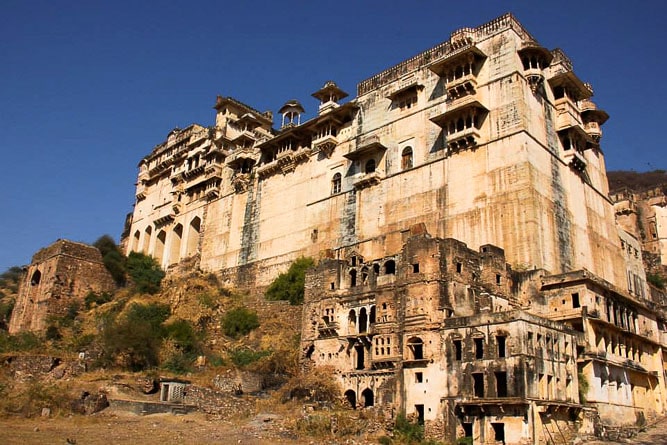Garh Palace
Palace in Bundi
should-see attraction
Opening hours: 8:00am-6:00pm
Address: Sadar Baazar, Teerath, Bundi, Rajasthan
Ticket price: Indian palace/fort/camera ₹80/100/50, foreigner palace, fort & camera ₹500
Visit duration: People typically spend up to 1.5 hours here
Website: www.garhpalacebundi.com
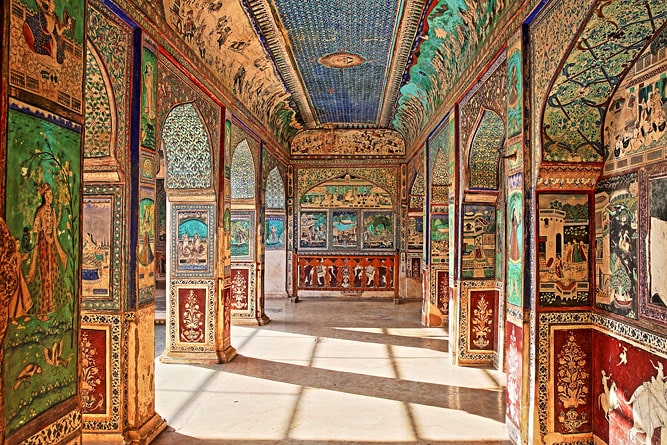
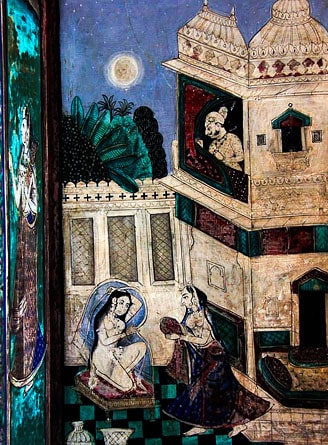
About the Garh Palace, Bundi
Bundi’s Garh Palace has served as the residence of the royal family. One of the striking features of this palace is that it remained untouched by Mughal architectural influence.
The palace of Bundi paints a vivid picture of the opulence and grandeur of the royal lifestyle that Indian kings and queens led.
The architecture showcases traditional Rajasthani architecture in a measured blend with Deccani art elements. It stands as a testimony to the uniquely rich Bundi artwork.
The Garh Palace is being slowly reclaimed by nature as tall grasses have covered some parts of the complex.
History of the Garh Palace
Indian king, Raja Rao Ratan Singh Hada initiated the construction of the Garh Palace in 1580. His successors continued to boost the architecture of the palace. The royal lineage inhabited the palace until 1948.
Diwan-i-Am or the Hall of Public Audience was built in the early 17th century while the Chhatra Mahal was built by Rao Raja Chatra Shabji in 1644. An antechamber was added in 1780 and the Phool Mahal was constructed in 1607. The murals were later on included in the 1860s.
The murals of the palace belong to the Bundi School of Painting, a significant Rajasthani technique of Indian miniature painting. The paints used in this technique are natural colours sourced from minerals, vegetables, precious stones, silver and even gold.
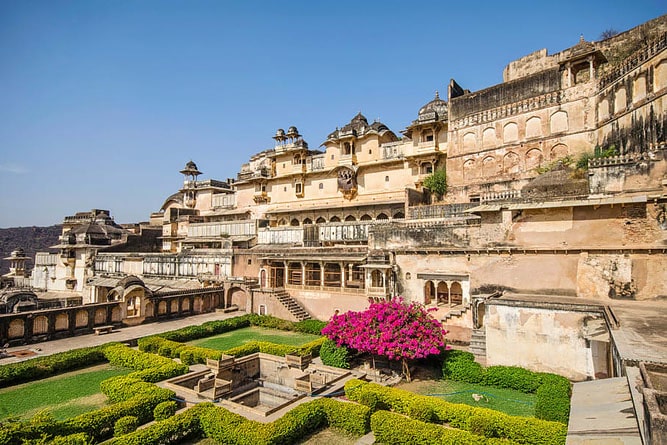
Architecture of the Garh Palace
The Garh Palace complex includes the Hathi Pol, Deewan-E-Aam, Chattar Mahal, Phool Mahal and Badal Mahal.
The palace exemplifies pristine Indian architecture with Chattris or Rajasthani-styled canopies and latticework or Jhali designs built from sandstone. You can witness a beautiful blend of pleasant Rajputana architecture and the Bundi School of Painting here.
The first entrance gateway of the Garh Palace has images engraved on both sides along with the archway. It is painted in a yellow shade and the engraved images are highlighted by red paint. A narrow lane of bright, colourful floral paintings runs across the immediate edge of the wall. The walls of the palace are immersed in the shade of beige and the pillars, chairs and walls present the intricate craftsmanship of the workmen of the ancient time.
The palace is surrounded by hills on its back which fortifies the defence. A small garden is settled at the facade. The garden has a water basin that is enclosed on four sides with a sitting area carved from sandstones which is designed following the Jhali pattern.
The palace has spacious arcade columns and a massive open gallery with decorated brackets and pillars. The walls have alcoves of various sizes that are ornated with arabesque and floral carvings. The walls also have inscriptions.
The Hathi Pol or the Elephant Gate is another gateway to pass through which has a small arcade column ornate with engravings. Through the Hathi Pol, you reach the primary courtyard of the palace which ushers you to the stairs to Diwan-i-Am or the Hall of Public Audience which houses a white marble coronation throne. The massive gallery on the first floor leads to the Chhatra Mahal or the open-sided pavilion.
The door to the interior court has paintings on all three sides of the door with two cows painted on either side. The Chhatra Mahal leads to a smaller courtyard, the Phool Mahal. The countenance of the Garh Palace shifts as you walk towards the court. The Phool Mahal exhibits the formal attires of the kings, arms and ammunition used in battles, and other interesting artefacts.
From the pillars to the walls, the interior is embellished with ancient paintings. The pillars of the arcade column have small mirrors with detailed carved frames and paintings drawn within a limited canvas on each side of the pillars. The walls have alcoves and mirrors with intricate frames.
Each painting is segregated from the other, projecting a clean and pristine look to the interior. The plinth and the brackets have Rajasthani patterns engraved on them. Finally, you reach the Badal Mahal, also known as the Chitra Shala.
The walls are decorated with colourful Ragamala paintings, arabesque, floral and geometric patterns which deliver a delightful ambience. The illustrations showcase the artistic talents of the workers. The paintings are dominated by the theme of Lord Krishna and his Rashleela in different hues.
The Garh Palace also captures the memories and incidents of the royal court through its paintings. The ceilings are animated with colourful arabesque paintings. The different colours of the paintings are complemented by the dominant hues of blue and green.
The palace has unique and captivating artwork that has continued to strive with elegance even after centuries. The palace prevails with outstanding, fading turquoise-and-gold murals.
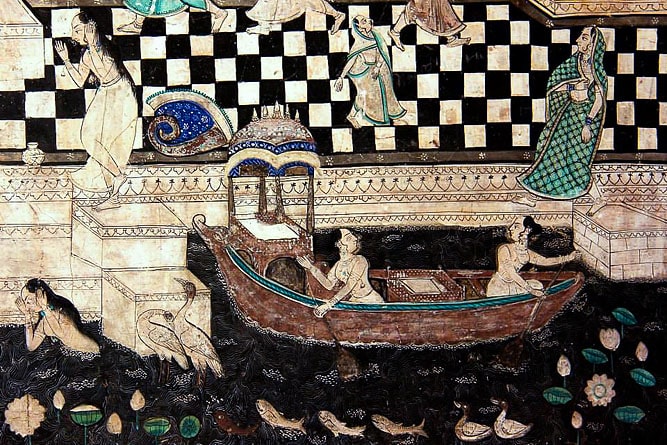
Entry fee and timings
The Garh Palace is open every day. In summer, the palace is open from 8:00 am to 7:00 pm and in winter, it opens from 8:00 am to 6:00 pm.
The entry fees to visit the palace is ₹80 for Indians and ₹500 for foreigners. While foreigners' entry fee includes a visit to the fort and camera charges, Indians pay ₹100 to visit the fort and ₹50 for camera charges. For shooting videos, the fee for all is ₹25.
Facts and tips about the Garh Palace
- Inside the Garh Palace, the entry tickets are verified once again after crossing the Hathi Pol. So keep the ticket after entering.
- The local guides' charges are steep. If you want to explore the palace’s history, you can hire one.
- The Sheesh Mahal is inlaid with mirrors. The Chhatra Mahal contains a collection of awe-inspiring pictures while the Badal mahal has a Chinese-inspired ceiling.
How to reach the Garh Palace
The Garh Palace dominates the city of Bundi. Taragarh Fort is just a few minutes walk away and it takes 5 minutes by car to reach Raniji ki Baori.
See location on Google Maps
Other attractions near the Garh Palace
- Taragarh Fort - 450m
- Raniji ki Baori (Queen's stepwell) - 1.2 km
FAQs about the Garh Palace
1. Is the entire palace accessible to tourists?
No, many parts of the Garh Palace are still closed up and left to the bats.
2. Are there any good places to eat near the palace?
Yes, there are a lot of local eateries near the palace where you can enjoy the regional dishes of Rajasthan.
3. What is the cost of the tour guide?
The cost of the tour guide is almost close to ₹500.
